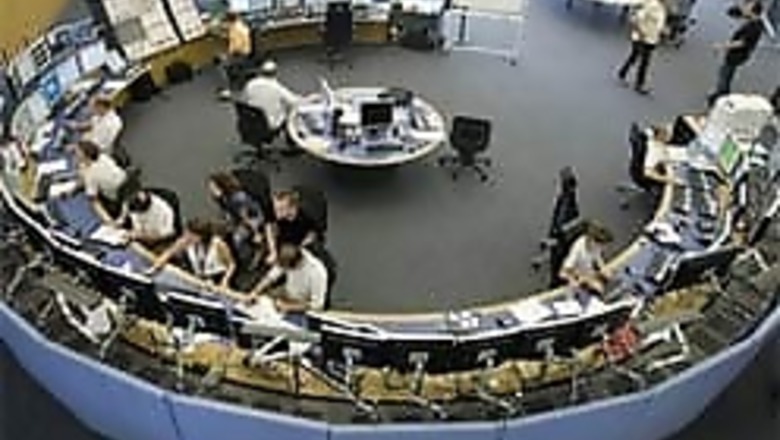
views
Geneva: Scientists will launch an experiment in a tunnel deep beneath the French-Swiss border Wednesday, hoping to find evidence of extra dimensions, invisible ''dark matter,'' and an elusive particle called the ''Higgs boson.''
And although leading physicists such as Stephen Hawking say the atom-smashing experiment will be absolutely safe, some skeptics fear the proton collisions could unleash microscopic black holes that would eventually doom the Earth.
The most powerful atom-smasher ever built will produce collisions of protons traveling at nearly the speed of light in the circular tunnel, giving off showers of particles that will provide more clues as to how everything in the universe is made.
In the $10 billion project -- the most extensive physics experiment in history -- the Large Hadron Collider will come ever closer to re-enacting the ''big bang,'' the theory that a colossal explosion created the cosmos.
The project, organized by the 20 member nations of the European Organization for Nuclear Research -- known by its French initials CERN -- has attracted researchers of 80 nationalities. Some 1,200 are from the United States, an observer country that contributed $531 million.
The collider is designed to push the proton beam close to the speed of light, moving around the 17-mile tunnel at 11,000 times a second at full power. Ramping up to full power is probably a year away.
Smaller colliders have been used for decades to study the atom. Scientists once thought protons and neutrons were the smallest components of an atom's nucleus, but experiments have shown they were made of still smaller quarks and gluons, and that there were other forces and particles.
The CERN experiments could reveal more about ''dark matter,'' antimatter and possibly hidden dimensions of space and time. It could also find evidence of the hypothetical particle -- the Higgs boson -- which is sometimes called the ''God particle.'' It is believed to give mass to all other particles, and thus to matter that makes up the universe.
The two beams of protons will travel in two tubes about the width of fire hoses, speeding through a vacuum that is colder and emptier than outer space. Their trajectory will be curved by supercooled magnets -- to guide the beams. The paths of these beams will cross, and a few protons will collide. The two largest detectors -- essentially huge digital cameras weighing thousands of tons -- are capable of taking millions of snapshots a second.
Some skeptics have said the collisions could result in tiny black holes -- subatomic versions of collapsed stars whose gravity is so strong they can suck in planets and other stars.
Micro black holes produced by a collider, the critics theorize, would move more slowly and might be trapped inside the Earth's gravitational field -- and eventually threaten the planet.
''It's nonsense,'' said CERN chief spokesman James Gillies.
John Ellis, a British theoretical physicist at CERN, said doomsayers assume that the collider will create micro black holes in the first place, which he called unlikely. And even if they appeared, he said, they would instantly evaporate, as predicted by Hawking.
Gillies told The Associated Press that the most dangerous thing that could happen would be if a beam at full power were to go out of control, and that would only damage the collider itself and burrow into the rock around the tunnel.
''On Wednesday, we start small,'' Gillies said. ''What we're putting in to start with is one single low intensity bunch at low energy and we thread that around. We get experience with low energy things and then we ramp up as we get to know the machine better.''
Huge amounts of data will pour in -- so big that the lab's computers can't sift through it all. So scientists, who will monitor the experiment at above-ground control centers, have devised a way to share the load among dozens of leading computing centers worldwide.
The result is the ''LHC Grid,'' a network of 60,000 computers to analyze what happens when protons are hurled at each other. That computing power is needed if scientists are to find what they are looking for among the mountains of data.
''You can think of each experiment as a giant digital camera with around 150 million pixels taking snapshots 600 million times a second,'' said CERN's Ian Bird, who leads the grid project.
Sophisticated filters discard all but the most interesting data, still leaving some 15 petabytes to be analyzed. That's enough to fill 2 million DVDs.
The data will be sent to 11 top research institutions in Europe, North America and Asia, and from there to a wider network of 150 research facilities around the world for scrutiny by thousands of researchers.
Collaborating on such a large project has proved invaluable, said Ruth Pordes, executive director of the Open Science Grid at Fermilab in Chicago. The U.S.-government funded project is among the major contributors to the grid.
''We are doing things that are at the boundaries of science,'' Pordes said. ''But the technologies, the methods and the results will be picked up by industry.''
Scientists expect grid computing to become more widely used, for research ranging from new drugs to nuclear energy. Eventually, consumers will start seeing it in daily life to regulate traffic, predict the weather or help a flagging economy.
So even if the LHC experiment doesn't yield answers to the cosmic questions, historians may one day see it as a key step in developing networked computing.
It wouldn't be the first time that has happened at CERN. In 1990, a young British researcher there created a computer-based system for sharing information with colleagues around the world.
He called it the World Wide Web.

















Comments
0 comment